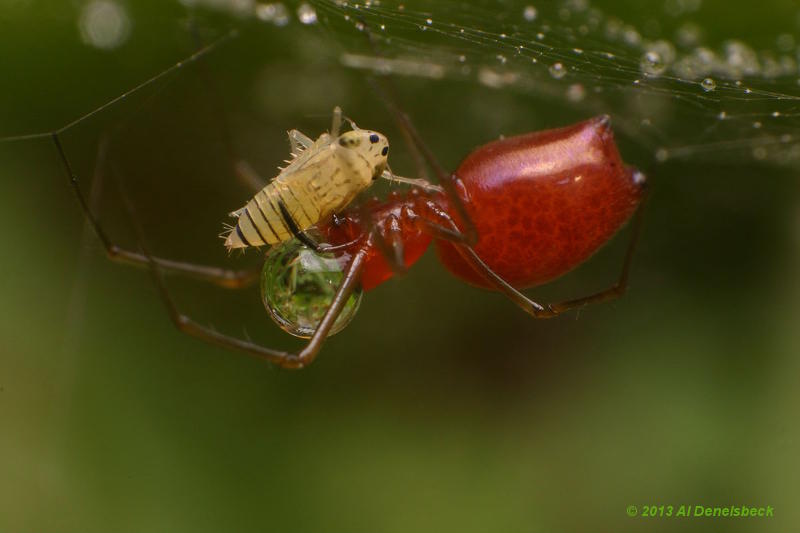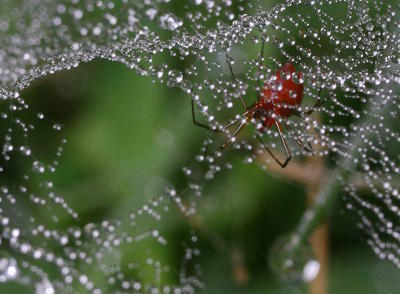Canon
300D, handheld
Sigma 28-105 reversed at 28mm, f16
Sunpak FP38 flat panel flash with softbox/diffuser
1/200, ISO 200
Canon
300D, handheld |
| Sometimes I impress myself | |
 |
|
All right, let me paint the scene. On dewy or foggy mornings, you may step out to discover a yard full of palm-sized webs stretched very low among the blades of grass. It would be easy to believe that they come with the conditions, but in truth they're probably always there in the morning – you just can't see them without the additional moisture.
One of the culprits is the Florinda coccinea spider, a tiny and secretive little spud that, despite its bright carmine coloration, can be exceptionally hard to spot, partially because it typically sits on the underside of its sheet web, but also because it's under 4mm in length. To give an idea, that's less than the thickness of 3 pennies...
In this particular case, the web was suspended a little higher than usual, with a gap in the grasses to one side that I thought I might be able to get a view through, shooting sideways right down at ground level. As I started to ease myself and the camera into position, I spooked a little leafhopper nymph, which hurtled into the web and was immediately snagged by the owner. This little bit of serendipity meant that the spider was inclined to consume its meal out in the center of the web, and not get spooked into a hiding spot like usual – provided I kept moving carefully, that is.
As for the dewdrop on the head? That was likely picked up when the spider scampered out to snag the leafhopper, and while it was probably obscuring nearly all vision that the spider might have, it wasn't inclined to brush it free in any way; there really wasn't a need at that point. And it made for an interesting tableau. If you look close, you can see the drop acting as a lens for the grasses beyond (out of focus to my lens) while the bottom surface is hinting at an inverted view of the flash-lit canopy of the dew-covered web itself above the spider. Meanwhile, the reflected rectangular shape of the flat-panel flash can be seen on the upper surface of the dewdrop, as well as on the abdomen of the spider itself. As close as I was working with the flash off on a short bracket to one side, the flash is actually above the web. Believe me, there was a lot of luck involved to get conditions that I could exploit in this manner.
 This is a another look at the web, from a slightly more typical view; the spider hanging out underneath, while each strand has captured a heavy load of dew that makes it visible in the first place – and all this would be down at ankle level or lower. Believe me, when I attempt subjects like this, it's usually experimentally, with the knowledge that I'm pushing the limits and will quite often get nothing usable. When it results in something as interesting as the image above, well, I'm stoked...
This is a another look at the web, from a slightly more typical view; the spider hanging out underneath, while each strand has captured a heavy load of dew that makes it visible in the first place – and all this would be down at ankle level or lower. Believe me, when I attempt subjects like this, it's usually experimentally, with the knowledge that I'm pushing the limits and will quite often get nothing usable. When it results in something as interesting as the image above, well, I'm stoked...
